page 40
Note: the contents of this page as well as those which precede and follow, must be read as a continuation and/or overlap in order that the continuity about a relationship to/with the dichotomous arrangement of the idea that one could possibly talk seriously about peace from a different perspective as well as the typical dichotomous assignment of Artificial Intelligence (such as the usage of zeros and ones used in computer programming) ... will not be lost (such as war being frequently used to describe an absence of peace and vice-versa). However, if your mind is prone to being distracted by timed or untimed commercialization (such as that seen in various types of American-based television, radio, news media and magazine publishing... not to mention the average classroom which carries over into the everyday workplace), you may be unable to sustain prolonged exposures to divergent ideas about a singular topic without becoming confused, unless the information is provided in a very simplistic manner.
Let's face it, humanity has a lousy definition, accompanying practice, and analysis of peace.
This selection is a follow-up to the previous page in reference to the stool with respect to types of seating. The following two images reflect a 1- 2- 3 arrangement of seating, even though some readers might want to offer the opinion that a bench seat such as at church, picnic table or sports bleachers can accommodate many more than three persons. In such a situation the interpretation than resorts to the old labeling system of one- two- many (or much), such as a knife = 1, a fork (entomologically speaking in terms of branching in two ways) = 2, and the spoon reflects the cognitive organization of much or many... such as in the case of the "one, two, many" words being used for describing early counting sequences.
Interestingly, the article below points out that periodic moments of reinventing old ideas was a common theme in the thinking of different cultures, not only because of the recurring pattern of human physiology, but because of a recurrence in cognitive architecture... all of which is being overlooked as a product of an environment (and not merely culture) that goes through a cyclicity of death and rebirth... within a planetary deterioration which is creating the conditions for limiting human thought as a survival mechanism. In other words, a poor memory affords a species the ability to reuse former ideas aided by one's cultural embellishments to give the impression that something new (if not original) has been created; where in fact the basic designs of old have simply been thrust into a production utilizing the prominent materials of a given era. This then suggests a limitation... a conservation of human thinking. While there may indeed be true bursts of original thinking from time to time, commercialization tends to bury it because those interested in making a buck do not often have the capacity to understand... much less make usage of such creativity. It's like Einstein when he provided his 1905 papers only to find that few people initially grasped the significance of his new ideas. Most people, if not whole civilizations, appear to be inclined to repeat what has come before (even if they are unaware of the repetition) because they have a commercial system set up to function in a traditional way with traditional tools by those whose minds are oriented towards one or another tradition... even though (as in the case of furniture construction)— a flexible design may be put forth to address an occupation, such as lifting, lowering, tilting, recycling or performing multiple functions such as a ladder, bench, chair, easel, etc...
Because seating is an integral part of human life, be it for placement on the ground, air (plane, jet, spacecraft), ship/boat, or otherwise (bicycles, motorcycles, horse-drawn wagons, vehicles, road equipment, conference rooms, Dr's office, stadium, courtroom, etc...), a review of it is helpful because it compartmentalizes many behavioral themes into a single subject... even though such themes are crudely referred to as "ergonomics". It not only deals with perception, but a loss of awareness through disusage, destruction, or even artistic distortion, and then a resurgence of the old becomes embraced as a treasure in a new garb... but the old skeletal framework remains... thus indicating a repetition of thought due to a repetition of influence... and the larger environment is an influence which is incrementally deteriorating... thus requiring us to make transitional changes in our ideas as a means of finding some measure of equilibrium. However, those changes appear to be more on the order of embellishment than an actual original idea... which might well set into motion a conflict with established traditions which are following along the course of the deterioration like a draft horse having walked the same path again and again. For example, if there is an unrealized change taking place in the human physiology to the extent that all forms of seating eventually become labeled with some Goldilocks remark that they weren't right... and that even the small one which she chose became unsuitable... furniture manufacturers would be faced with a dilemma because all forms of traditional seating were fashion for a frame of body... and a frame of mind that was making everyone a bit uncomfortable because they were acting as constraints to individualized evolution-linked developments. This same idea can be applied metaphorically to the peace/war discussion if we look upon it as a piece of furniture, with or without hinges, drawers, legs, arm/back rests, upholstery, footrest, padding, tacks, ornamentation, etc...
Whereas war has had many philosophies of design change, and furniture as well as art has had a few, the design of peace retains its primivity in both thought and practice. It's past time for peace to have its Renaissance.
3-patterned arrangement
of furniture: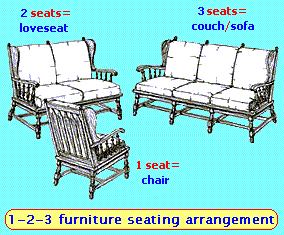 --- Sofa and Couch plans --- |
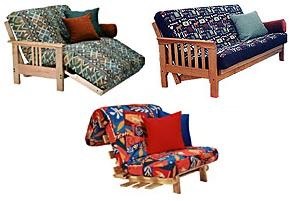 --- 3 types of Futon frames --- Top left: Loveseat Top right: Bifold Bottom: Trifold |
Source: Various 3's examples page 14

Kim Gurr1, Leon Straker and Phillip Moore
Curtin University of Technology, Perth, Western Australia.
1This paper is based on the Postgraduate Diploma in Ergonomics research project performed by Kim Gurr under the supervision of Leon (Physiotherapy) and Phillip (Social Sciences). Kim died unexpectedly before finalizing this paper.
AbstractSeating is an important issue for contemporary ergonomics. Its frequent use by humans and its association with musculoskeletal disorders are just some of the reasons for its importance. To understand the place of seating in modern Western societies it is useful to understand its history. This history is also important as we consider transferring Western ergonomics research on seating to 'other' cultures.
This paper presents an overview of the ancient and modern history of Western seating, with particular emphasis on the design influences over this 5,000 year period.
1. IntroductionThe history of supported sitting or seating, has a long and colourful history beginning at least with the Egyptians some 3000 B C. The types of seats used and their functions have undergone a myriad of changes over the millennia, providing a useful insight into how our current understanding of seating in contemporary Western society arose. We present a linear temporal view of the historical development of seating to trace the influences of culture on the design and the functional purpose of seats. The historical knowledge summarized here is distilled from a great variety of texts, for it seems our fascination with the 'chair' is as alive today as it was in ancient times.
As an introduction to the history of seating, it should be noted that despite the huge amount of information documented on seat types, only three types of distinctively different seats developed. These were the stool (both fixed and folding), the bench and its antecedent the chest, and the chair. Associated with the development of the seat are other objects, many of which remain with us today, such as the table and footstool.
It is also interesting to note the different groups involved in the development and production of seats, as their tools, materials and knowledge were integral to the designs which emerged during the different periods. Basically the initial chair or seat makers were the carpenters and then the joiners, who were followed by the cabinet maker and craftsman. They were followed by the decorator, then the upholsterer until the beginning of the Twentieth Century, at which time the inventor emerged, to be closely followed by the architect and then the professional designer. Most recently seating has become part of the domain of the ergonomics profession. All these groups have been responsible in their various ways for the development of seating. Of course their behaviours and actions have been constructed within their cultural frameworks, for example, the seat has often been associated with political power, religion, art, and the notion of aesthetics throughout its long evolution.
The study of history can sometimes fool us into the belief that societies progressively improve on what has come before, as our body of knowledge increases. This notion is dubious, and the reader will note the 'ruptures' in the historical progression of seating within Western culture. We hope to present a reasonably concise view of the history of seating that will be of interest to ergonomists, and in particular to raise some questions about the quite evident ruptures we find in its development. For it seems we do not march slowly forwards to an ultimate solution in this regard, but rather we tend to reinvent and then forget.
The ancient history of furniture comes to us principally from the art records left to us by earlier societies. Occasionally, such as in the case of Tutankhamun's tomb, real pieces can be examined and described first hand. Given that this history is based principally upon pictorial records, some generalizations are often made by writers in the field to create a cohesive picture for their readers. This paper should be read with this caveat.
2. Ancient History2.1 The Egyptian Era (3100 - 475 BC)
"The Egyptians equipped their houses with great skill. They developed benches, folding beds, and especially chairs and stools of various kinds. The chairs are adapted to either squatting in the oriental manner - in which case the piece is lower than normal and its seat is deeper - or to sitting with ones legs hanging down in the western manner." (Geidion, 1948) p. 259
The ancient Egyptian furniture was in general lower in height than contemporary furniture with beds being about 300mm high and the stools being extremely low by modern standards. "As to the lowness of the seating pieces, the short stature of the early Egyptian people may have had some influence, their average height being only a few inches over five feet (Baker, 1966) p. 21." However, their chair remains indicate them being quite high off the ground, requiring a footstool to be reached, and once seated the footstool was used to support the sitter's feet.
The stool appears to be the most common and perhaps earliest piece of furniture developed by early Egyptian culture, as seen in the early sculpture in Figure 1. It was used throughout society for a variety of functions.
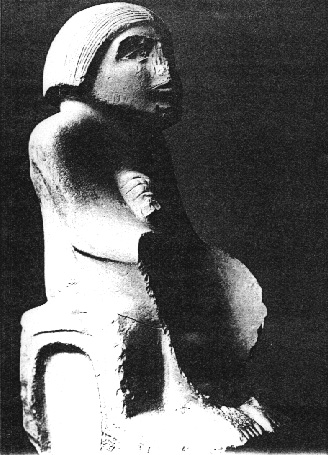
Figure 1. Early Egyptian stool.
By the time of the Second Dynasty the stool appears to have differentiated into a new form reserved for royalty and high ranking members of society. It became more substantial in its construction, sometimes having a low back rest and was often higher than the stool. Sometimes a cushion was added, or so it would appear from historical records. Figure 2 shows an example of these early chairs.
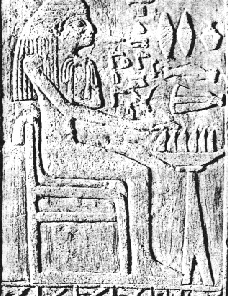
Figure 2. Early Egyptian chair.
The addition of a low backrest to the chair is an interesting development that is not seen again in the history of the chair. From the historical record it would seem the low backrest is supporting the pelvis and sacrum in a fixed orientation, allowing the lumbar spine to move fore or aft to a point of balance (See Figure 3.).
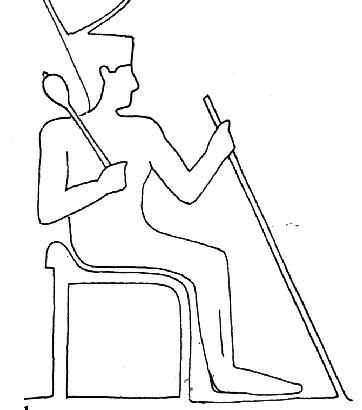
Figure 3. Egyptian chair with 'sacral' support.
By the Fourth Dynasty the chair reached a high point in its refinement and elegance (see Figure 4), After then the seat in its two forms (the chair used by nobility and royalty and the stool used throughout the rest of the society) remained virtually unchanged for twelve dynasties (to around 1320 B C).
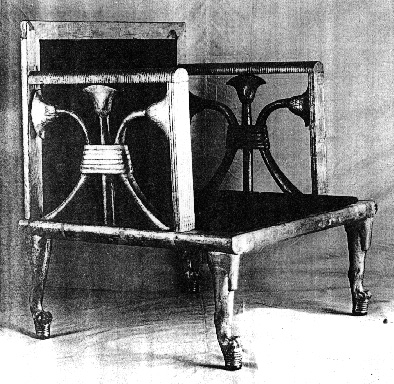
Figure 4. Fourth Dynasty Egyptian chair for Queen Hetepheres.
As can be seen by the chairs depicted in Figure 5, sitting postures still included a folded leg position, with the chair's large seat area making this possible. It is also interesting to note the footstool with some of the taller of the chairs. The sitting postures shown with the legs hanging down, resemble very closely that shown in anthropometric tables used by today's furniture designers, with the thighs being parallel to the floor. To achieve this posture the Egyptians regularly used footstools, as stand alone objects, or built into the construction of the chair (see Figure 6.). No mention was made in the literature reviewed as to whether the furniture was custom made for individuals or whether a standard size had developed.
 Figure 5. Sitting posture options offered by Egyptian chairs. |
 Figure 6. Use of footstool with Egyptian chair. |
Another interesting and quite distinctive chair style that developed late in Egyptian culture was the single curve and later the 'double curved' seat section of the chair, shown in Figure 7. It is not clear whether this style developed for aesthetic reasons or for comfort.
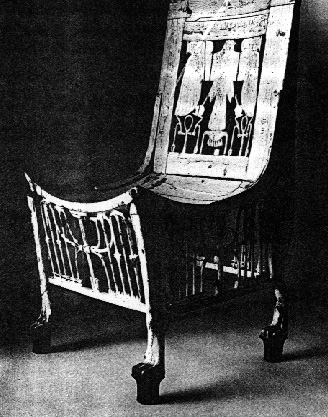
Figure 7. Double curved Egyptian seat.
Stool designs with similar shapes are also recorded. The folding stool shown in Figure 8 represents a typical example of this variety. Leather or a material weave would form the seat section or 'stretcher' of the stool. Perhaps the naturally formed curve assumed by the seat when sat upon was imitated in the solid construction stool and the chair.
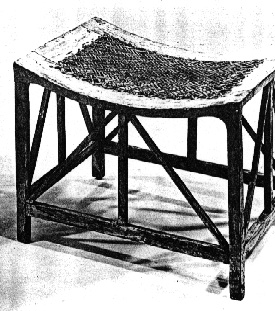
Figure 8. Curved Egyptian stool.
Egyptian furniture and in particular chairs, evolved into some quite complex forms, requiring a high level of skill in their design and crafting as demonstrated in the construction details in Figure 9.
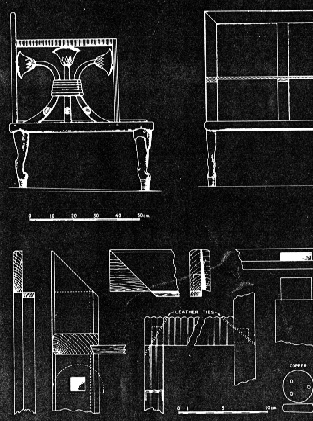
Figure 9. Construction details for Egyptian chair.
It is worthy of note that the timber workers of this period were limited to copper tools, and that as far as historian are aware the lathe had yet to appear. The chair with a sloping backrest remained the domain of the kings and privileged classes, while the general populace used stools, squatted or sat on a mat.
"The furniture of the upper-class home in Egypt differed little in its range of types from that found in Tutankhamun collection. The royal beds, chairs, stools, tables and chests had their counterparts in the houses of the well to do, but, as might be expected, the villa furniture was less ornate and, for the most part utilitarian... The ancient peasant, like the modern fellah, was accustomed to sit in a squatting position on the ground and so had no need of chairs." (Baker, 1966) p. 1102.2 The Ancient Mesopotamian Era
The Mesopotamian empire developed concurrently with the Egyptian culture, and it is clear that there was some interaction between the two, as seen in the similarity of some of their furniture. It is known that stools and some chairs were in use around 3100 - 2370 B C, as evidenced in the remains of pottery and seals recently excavated, however beyond this there is little record of this period. It is believed that the Mesopotamians" ...lived at ground level, upon mats and rugs with little more than cushions to give support" (Hayward, 1975) p. 284. The exception to this way of sitting were the kings and nobility, and for the gods, represented in the art of the time (see Figure 10). "Among earlier representations there is scarcely ever more than one seated figure, whose seat takes one of the number of forms, from a simple bench to an elaborate high backed chair with a cushion turned legs and decorative features" (Hayward, 1975) p. 284.
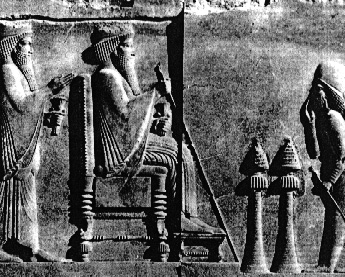
Figure 10. Chair of Darius, King of Persia.
From the Akkadian period to the end of the Kassite period (2370 - 1150 B C), evidence of cross legged stools and a box shaped stool with lattice side panels are found.
The seats with the grid pattern in their sides have especial interest not only because of the frequency with which they appear in the seals of the period, but also because of the resemblance to a construction popular in Iraq today...Crates to hold vegetables and fruit are made in the same manner and it seems likely that we have here an example of a craft that has continued with little change for more than 4,000 years. The seat of the chairs are made of woven rush - craft known from prehistoric times. (Baker, 1966) p. 171.
Throughout this period, sitting on a stool or chair without a backrest was quite popular, at least as far as records can tell us. "In the seals of the old Babylonian period the simple wooden stool with rounded legs and a single stretcher appears so frequently it seems probable that this was the seat most generally used at this time" (Baker, 1966) p. 172
The Assyrian and Neo Babylonian periods in Mesopotamia (1350 - 539 B C), see the chair and table being used together in artefacts depicting eating scenes. The chair is of a high backed variety, similar to that developed in Egyptian culture. The chair with the sloping back (evident in Egypt at the time), does not appear in Mesopotamia, even though it was apparent trade and cultural interaction occurred between the two regions. From the records remaining from this period it seems the high backed chair, often used with a footstool remained furniture of royalty and a privileged class.
In general there is a rigidity in the furniture portrayed, particularly in chairs, that perhaps reflects the severity of the people who owned it. Long before this time Egyptian chairs were made with a sloping backrest curved to fit the body. Such chairs were known to the Mesopotamians, but they are missing from the furniture portrayals of this period in Mesopotamian art. Instead there are tall straight chairs on which the occupants sit bolt upright. (Baker, 1966) p. 205.
2.3 The Aegean Era (3000 - 2000 BC)The Aegean region was to become a cultural centre for the development and refinement of supported sitting, and most particularly with regards to the chair. However few records remain of this period to indicate the types of furniture used. The notable exception is a miniature sculpture of a seated harp player (See Figure 11). How close this representation was to reflecting actual seating behaviour remains a mystery. It is significant to note that this style of chair had no apparent design link to the Egyptian or Mesopotamian furniture of the time. The sparsity of information from this period may ensure that the origin of this chair remains a mystery.
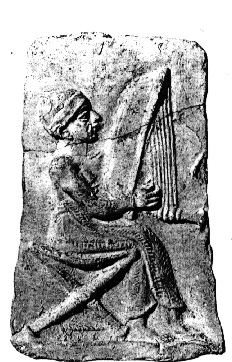
Figure 11. Aegean stool c. 2000BC.
The Minoan's furniture history comes to us from the excavated ruins of the 'Palace of Minos' at Knossos. This period of development is sometimes known as the first civilisation of the European world, having elements of an advanced urban life and a well developed city; with the Palace of Knossos at its centre, and "surrounded by fine houses, villas and artisans residences". (Baker, 1966) p. 240
Unfortunately Knossos was destroying most of the relics from their civilisation. The throne of Knossos; constructed of stone, is one of the few remaining examples of furniture from this period. Figure 12 shows the throne and surrounding benches. Representations of stools were also found, similar to those used by Egyptians of the time.
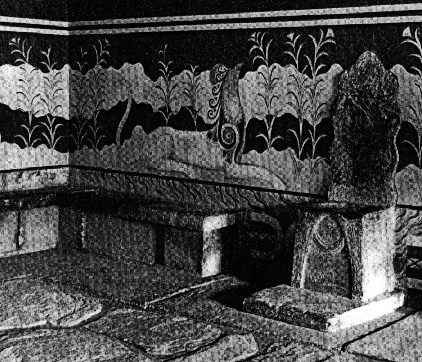
Figure 12. Minoan chair and benches.
This era remains of great intrigue to historians as few records remain. It is the time of Homer and the Odyssey. Our knowledge of this time is constructed from the tales passed down through the generations, and most recently from the deciphering of some stone tablets (Linear B) in which chairs, tables and footstools are mentioned, "the descriptions give but few clues to the actual appearance of this furniture". (Baker, 1966) p. 249 but it is known they used benches, stools, high seats requiring the use of a footstool, and chairs with backrests that could be moved with some ease.
The Mycenaen civilisation ended abruptly around 1200 BC with the palaces burned and all records lost. The next five hundred years remain a blank as far as the archaeological record of furniture is concerned, and is sometimes referred to as the 'dark ages' of Greek history. The story is not picked up again until 800 B C.
2.6 The Early Greek Era (750 - 475 BC)This is a period of sophistication in design represented in the paintings and sculpture of the time. Banquet couches for sleeping or dining are common. The Greeks had become accustomed to eating in a reclining pose. It seems it was common for men to 'lounge' together, each with his own couch, eating from low tables that supported their food as shown in Figure 13.
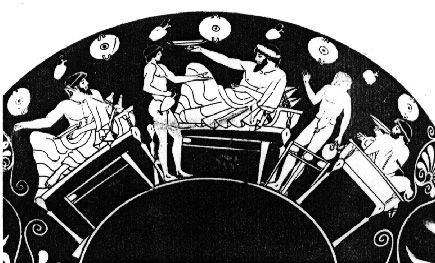
Figure 13. Greek couches.
The designers and craftsmen of this period produced a well finished and what is often referred to as 'classic' Greek design in the chair.
"...sometime in the early part of the Fifth Century B C the chair acquires a broad horizontal back slat at the top that encircled the shoulders of the seated person, and a fixed form of the classic chair is established... The backs of some chairs sweep back in an exaggerated curve...while others are straighter." (Baker, 1966 19) p. 279
The design appears to be of Greek origin, based upon the Egyptian and Greek thrones. The legs were generally curved, with a "back composed of three uprights fitted into a curved board at shoulder level" (Hayward, 1975 20) p. 15. The seats were light in weight and could be moved about a room as needed, providing flexibility in arrangement. They offered a new type of support for the back than the straight back, or slanted back chairs of earlier times. The backrest sweeps across the thoracic spine and supporting the back of the shoulders, as can be seen in Figure 14. From an aesthetic perspective the chair became composed of spaces and flowing lines. These chairs were to later form the basis of the design in the Eighteenth, Nineteenth, and Twentieth Centuries.
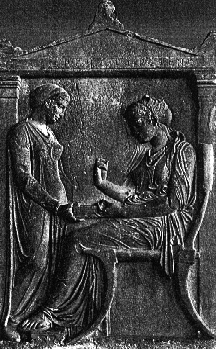
Figure 14. 'Classic' Greek chair.
The Greeks development of the couch, the chair and even the stool (see Figure 15) to some extent (which is evident throughout the Greek culture), seems based on a concern for the human form in their designs. Support is deliberately added to support the back, and perhaps it would be reasonable to suggest the first notions of 'Western comfort' appear in the designs. The seats appear in more common usage throughout the society, its use becoming a daily part of life for the 'well off Greek', and in particular the men and women of rank.
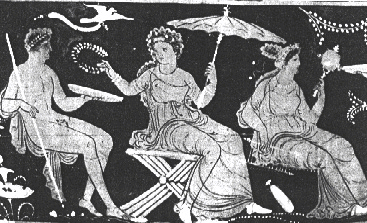
Figure 15. Greek stool.
The furniture of this period remained virtually unchanged from the 'Early Greek period'. "The Classical era, as it pertains to furniture and architecture, continued without a break in Greece and the Roman world until the time of Constantine; and, although interrupted for long intervals, its influence has continued until today" (Baker, 1966 19) p. 285. The chairs, stools, couches and tables of this time have remained an inspiration to furniture designers, determining form and functional use patterns by Western cultures. The Greek furniture styles of this time were widely dispersed by the Greeks, and later the Romans; being found throughout Asia Minor, Italy, southern Russia, North Africa, and eventually in the East, were the stool exerted a great influence.
The stool developed in two forms. One, termed 'diphros', often had four perpendicular legs and a rectangular seat, often with a cushion or rug for padding. The other stool became known as 'diphros okladias' in which the legs cross, as in the modern stool. These stools, sometimes quite elaborate in design, could fold to allow easy transport when traveling.
The use of benches on which to sit became a common part of Greek culture, used in schools and theatres and by philosophers and their audiences (see Figure 16). The benches sometimes had perpendicular backrests, but this was not common. The Greeks were also accustomed to sitting on the ground. Significantly perhaps, the 'speaker' would sit in an almost throne like chair, setting him/her apart from the audience.
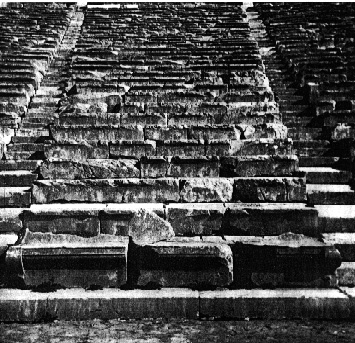
Figure 16. Greek theatre benches.
Footstools were in use whenever people sat in the higher chairs, see Figure 17. They were also used as a stepping stone to mount the high couches in use. As mentioned previously, the Greeks would eat in a reclining pose, food laid on table next to the couch. Once finished with, the table would be pushed under the couch.
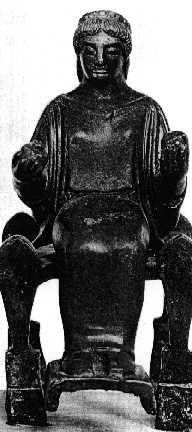
Figure 17. Greek stool with footstool.
Our notion of 'comfort' may be said to have derived from the Greeks, certainly they appear to have enjoyed their leisure time, adapting the chair for more comfortable support and developing furniture to suit their bodies in recline. It is with the Greeks, that the notion of supporting the body when sitting develops.
From this time on, excepting in the Roman Empire to follow, sitting in chairs becomes an almost foreign art, lost for centuries and revived only in the churches, and the halls of the powerful and wealthy.
2.8 The Roman EraThe Romans did not develop the furniture of the Greeks much further. Rather, they kept the designs and added to the ornamentation and decoration. General styles similar to those of the Greeks were found distributed throughout the Roman Empire. Thrones became quite distinctive (see Figure 18) and certainly in Rome the chair was a 'seat of power'. The collapse of the Roman Empire signals an end to the furniture seen in these times. It is not until the Seventeenth and Eighteenth Centuries that designs resembling the Greek and Roman styles re-appear.
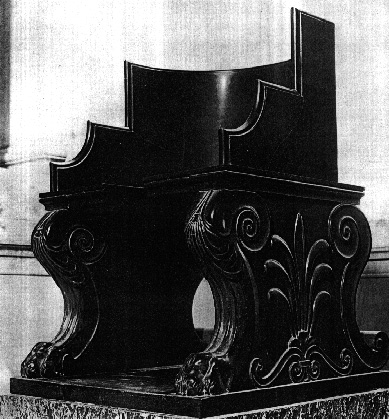
Figure 18. Roman throne.
When the nomads plundered Rome, they found chairs that made no more sense to them than the statues, the thermae, the inlaid furniture, and all the instruments of a differentiated culture. Their habit was to squat on the ground and so it remained. (Geidion, 1948) p. 262.
The traditions of the Classical arts were however not completely lost. The Christians took over the 'classical figures' and adopted them to their own uses. "...much of the legacy of antiquity was abandoned. All those lovely subtle curving shapes seen in Greek and late Roman furniture, the rounded backs and the sweeping sabre legs have vanished" (Hayward, 1975 20). The chair takes on an architectural form, usually massive in construction, and with a straight back (see Figure 19). The old skills had been swept away, and the craftsmen of this time using construction methods similar to older times, remodeled the chair anew. It was severe in its form and was only used by figures of power and authority, and for ceremonial purposes. Comfortable support did not seem a consideration. The notion of 'ascetic' was becoming popular in the monastic societies that were developing, with new furniture emerging to meet their needs. The handling of manuscripts and volumes of text encouraged the development of supported sitting in a new direction.
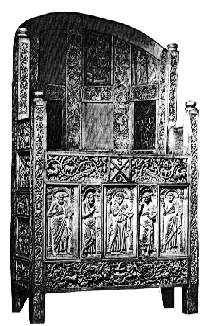
Figure 19. Byzantine chair.
The early Gothic period was a time without the chair for the general population. The three legged stool remained a part of everyday life, but sitting was a very informal affair. People where accustomed to seating in very close proximity to each other, often crowded together as shown in Figure 20.
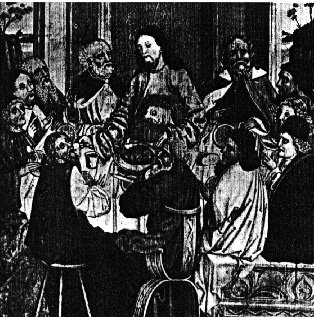
Figure 20. Gothic stool.
People sat on the bare floor and used cushions. They sat on stairs and steps leading up to the high posted beds. Romanesque chests...where for sacred purposes and much to high to have been used as seats. As chests became lower, we find them aligned along walls. They filled the role of chairs and couches. (Geidion, 1948 15) p. 264.
The chest became developed universal furniture of the Middle Ages (see Figure 21). They were portable, capable of storing ones' belongings, and they could be used to sit upon. A characteristic part of Medieval life was transience of abode. Living situations were often temporary, even with the nobility and kings, who traveled with all their worldly belongings, usually in great chest. Folding stools remained a useful addition to the travelers lot.
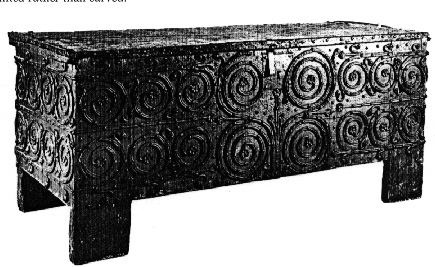
Figure 21. Gothic chest.
The chest's metamorphosis to the seat came about as people became less nomadic, and no longer required the security of a chest. As well, the chests of the time became quite ornate and uncomfortable to sit upon, and with the addition of the drawer the chest began its development as a 'chest of drawers'. The arrangement of chests around the walls became replaced by a continuous 'bench skirting', sometimes the whole circumference of the room.
The evolution of the chair remained in the hands of the monastics and scholars of the period. While the common man made use of upturned buckets, stools and crude wooden benches, the monastic communities were developing the chair for utilitarian functions, i.e. record keeping , writing and painting. They developed sloping tables, lecterns, and tables capable of angular adjustments to hold their books and papers at eye level as shown in Figure 22.
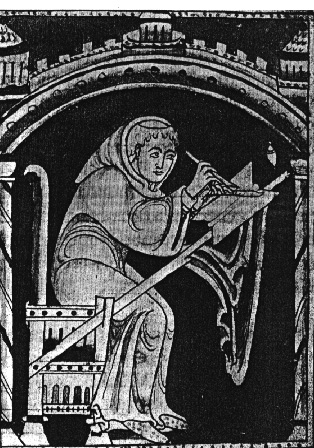
Figure 22. Gothic chair and 'desk'.
It was not until the Eighteenth Century that horizontal tables became the principal type for these type of activities, a period associated with the development of libraries. The sloped desk has never regained the popularity it had at this time. Some clever designs can be seen from this period. The idea of a 'water wheel' arrangement, as seen in Figure 23, is a good example of the ingenuity of the time.
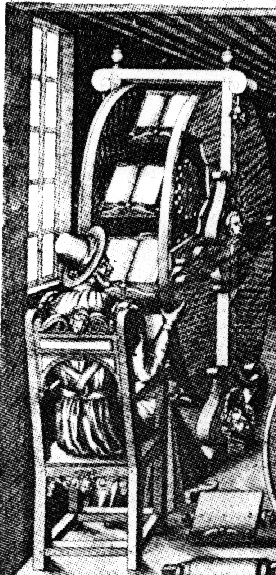
Figure 23. Gothic 'document holder'.
The chairs remained angular and austere in design, but often decorated and embellished in solemn tones. The high back-pieces were not intended to provide support and the hard angular construction of the chair would suggest to us the people of this time held a different notion of 'comfort' than contemporary society.
The monks were vowed to ascetic living. They little heeded such questions as how the body might best relax in a chair. Throughout its time the Medieval interior bore the marks of its austere origins. The ascetic ways of monasticism invisibly shaped the period in its own image. (Geidion, 1948 15) p. 301.
As the functions of the chair become more diversified, new designs begin to emerge such as the revolving chair, which first appeared in the Fourteenth Century, and was, by the Sixteenth Century highly refined. Its function was to facilitate the task at hand for the busy scholar. The use of hinges and pivots was commonly employed in the furniture designs of the time.
3. Modern HistoryFrom the Sixteenth Century onwards chair design could said to be of a European style, and in the Nineteenth Century an American influence emerges. Most of our historical pre-occupation with the chair comes from these times, as living examples still remain as insights to the periods. Many texts have painstakingly classified the seating styles, and throughout the remainder of this paper some of these classifications will be used to assist in the categorizing of the designs. It is not our intention to deal with each in its turn, but rather, to examine the contexts in which the changes occurred.
3.1 The Cabinetmaker EraBy the mid Sixteenth Century the chair was becoming a common piece of furniture throughout Europe. Made by cabinetmakers for the wealthier and noble members of society, the chair's design continues to become more diversified, often to meet the fashion tastes of the privileged classes. Chair design begins to move away from the heavy, and harsh angular shapes to a lighter design using frame construction, similar to that of the earlier Greek chair, incorporating flowing curves and a backrest intended to support the seated person. "Typologically speaking, it was the return of a forgotten standard: To create a support for the body that would allow highly relaxed posture. Posture and the chair are one". (Geidion, 1948 15) p, 301. the construction of the chair becomes almost skeletal in comparison to some of the earlier designs, as cabinetmakers employ quality joinery skills with fine pieces of timber to create what some describe as 'works of art'.
The chair designs were influenced by the tastes of the upper class and more powerful members of the society. It represented an expression of their tastes in furniture, and their rank. Perhaps a classic example of this type of influence is the role played by Napoleon Bonapart, considered responsible for the resurgence in the Greek and Roman styles of furniture. Employing architects sympathetic to his ideals, they resurrected the old styles using embellishments and designs from the Classical period. This influence spread throughout Europe as a populace clamoured for icons of a long lost past. This distinctive style in furniture design became known as the 'Empire design'; whose resurgence revived the idea of supporting the body with a backrest and often with armrests. "The curve intervenes...As its lines become fluid, the chair can adapt itself to the organic, to the body. The Seventeenth Century armrests and upholstered seat are relaxed and fused into a continuous curve, a shell moulded to the body". (Geidion, 1948 15) p. 312.
The 'chaise lounge' appears, a resurrection of the earlier Greek and Roman couch. New notions of comfort and posture emerge, based upon relaxation and support of the body in repose and upright sitting. Curved backrests, padded arm rests and the appearance of elaborate upholstery reflected a fashion that was to transcend the classical designs, as chair makers begin to adapt their designs to the idiosyncrasies of the human body. There are some authors however, who are of the opinion that the 'Classical Greek' designs were never surpassed in their beauty or form. The austere ascetic design of the Medieval age is forgotten, as a new culture reached into its past for forgotten origins. The chair becomes a work of art, highly regarded by the upper class, who at this time are the only group who can afford the luxury its use promised. The general populace were still using stools and benches, along with some crude copies of the contemporary styles. However, the chair was becoming a popularized object and with the commencement of the 'Industrial Revolution', its dispersion was guaranteed.
Men born into the first decades of the Nineteenth Century grew up in the firmly rooted belief that all products embodied high labour values and were to be won only by long toil. But now the machines began cutting to a fraction of their former cost, not only cotton goods, but also every product used in art and adornment." "Geidion, 1948 # 15] p. 345.
Along with this new notion of reproducibility of form, came a specialization of not only labour, but also of space. Rooms reserved for special purposes, i.e. library, lounge, bedroom and dining room, each with specific furniture requirements. What was once the domain of the elite was becoming available to the common people, with the chair considered an important acquisition. The chair represented a sign of power and wealth, its use indicative of a lifestyle. More relaxed and sometimes asymmetrical sitting postures become more common as the chair looks to providing more support for the body.
3.2 The Upholsterer EraWith the advent of new technologies, methods and materials the upholsterer emerges as the new chair designer. Chairs and stools had used cushions and limited upholstery previously, but only in a small way to augment the woodworker. New fabrics and many types and designs emerge from the textile mills, and the upholster finds many imaginative uses for them, none the least the adornment of chairs." (Geidion, 1948 15) p. 364.
The upholsterer took the outline form or 'skeleton' of the wooden chair and transformed it into a completely new form. Soft padded edges, voluminous cushions and plush materials allowed the chair to lose its previous shape. it becomes 'boneless' and relies upon cushioned padding to provide the support. Backrests rise up to encapsulate the sitter, the seat depth increases to allow a 'comfortable' sitting position, and padded arm rests invite a flailed leg or weary elbow. Slumped, passive postures were invited by the chair, with some of the chairs actually being called 'comfortables' (see Figure 24). These chairs made use of spiral springs placed in the base. Spring makers worked together with the upholsterer, to develop new shapes and styles, some not too dissimilar to the 'lounge suites' in use today.
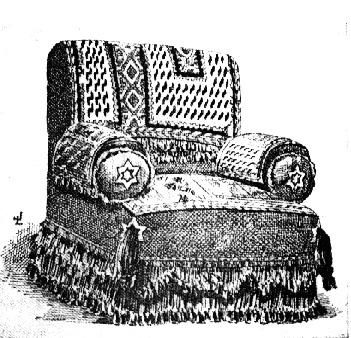
Figure 24. Fauteuil-Coussin Comfortable c. 1880.
Paralleling the rise of the upholsterer, other technologies were developing in the rapidly industrialized world. new ideas, materials and methods gave rise to the 'Patent' era in furniture design, which particularly flourished in the new colony of America. Patent designers, inventors and general gadget makers turned their energies to chair design. They became interested in the problem of motion; how to allow movement while supporting the body. The notion of adjustability and flexibility of design was paramount, as the new engineers dissected the chair into its planes, making each capable of regulated movement.
Patent designers left few stones unturned in their quest for relaxing and comfortable designs. Dentists and Barbers (previously the same professional group) chairs became fully adjustable in every conceivable direction in order to position the sitter in the most convenient position, whether for practical purposes or comfort. Railway seats for the new trains of the time could lay out flat, cantilevering above and below each other to allow the passengers a comfortable nights sleep (where have those days gone?). The chair became diversified in its form to meet each newly identified function, with support for the human body a high priority (see Figure 25). The notion of passively positioning people in chairs becomes well cemented in designs from this point forwards, however different notions of postured positioning emerge. Relaxation and comfort, as demanded by the new middle class became the 'Holy Grail', for these chair designers.
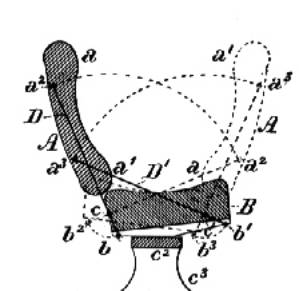
Figure 25. Train chair designed for support. c. 1885.
The American Patent Office in the 1870's had 70 sub-divisional categories for chairs of different purposes. Some of these designs were grotesque and awkward, while others took account of the 'human physiology'. While Taylor was timing work tasks, anonymous 'patent' designers were developing the first 'ergonomic' chairs (see Figure 26).
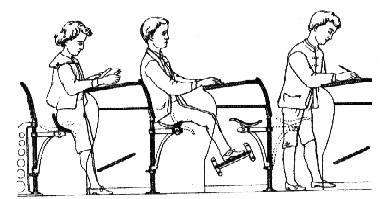
Figure 26. Sit-stand school seating. c. 1890.
Backache from sitting was recognized and accepted as a challenge by the Patent designers, and as a result the rocking chair was developed. This form was then merged with the revolving chair. Springs attached to the adjustable backrest, allowing the sitter to move anteriorly or posteriorly with continued support. At least that was the theory. The 'office' chair becomes a common part of the industrial age, while other specialized chairs fill market niches. The typist chair, which did not appear until the 1890's, some twenty years after the introduction of the typewriter, received considerable attention in its design (see Figure 27). The seat was often capable of sloping forwards, as was common in 'sewing machine' chairs of the time.
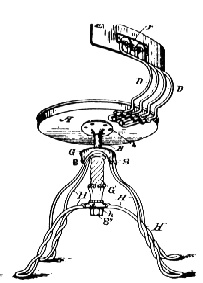
Figure 27. Typist chair of 1896.
The backrest was spring loaded to provide support to the typists shoulders as they moved position. The guiding principles in the design are concerned with postural support and comfort, whether sitting upright, leaning backwards or reclining.
Unfortunately many of the early patents have been destroyed and lost forever, along with the concepts they developed. Some of the chairs of this time remain as a scant reminder to an innovative and prolific period in chair design, that was to be for the best part, forgotten by the chair designers to follow.
3.4 The Architect EraThe beginning of the Twentieth Century was a time of revolt against the Patent furniture movement. Furniture was becoming an integral part of the house and office setting, with function assuming lesser importance to form. Aesthetic design became the guiding force, with the chairs place within, and its interaction with the space of the room of prime consideration. New materials in the form of steel tube, wire and later plywood provided designers with new scope for their designs and aesthetic notions, and as a consequence the way people sat was to alter again.
Around the 1920's the architects become the new guardians of chair design philosophies emanating from the German Bauhaus School. These designers were of the belief they were designing from a new premise, a new visual orientation of what the chair should be and how its form should interact with the space of the building into which it would become an integral component. The architects approached the chair as a form, rather than as a functional unit as seen in the Patent era. Along with this change in emphasis, the architects and their forms were to become famous for their work, as leaders in the avant garde world of design. Chair designers were no longer anonymous craftsmen or Patent holders, but rather, they became prominent social figures in their societies. Their often abstract designs were reflections and representations of their personalities and the new forms being created in their cultures. Experimental materials and the new qualities they provided, offered the architects the scope to construct previously unheard of designs, with the architecture of the building and the furniture used inside, designed to blend, to become one and the same. This notion remains with us today, and the later emergence of the 'interior designer', as a professional with specialized skills to coordinate a harmonious interior of a building; by combining colour, shape and form to achieve a balanced and spatially pleasant atmosphere within the building.
Marcel Breur, a famous student of the Bauhaus School incorporated the use of tubular steel, bent in smooth curves to imitate an earlier style of 'bentwood' furniture.
...the steel tubing worked with the taut canvas to spring the seat, and the back and the arm rests. Unlike the American Patent furniture with its mechanical mobility, this type uses the resilience, the springiness, of materials to provide a modicum of elasticity. (Geidion, 1948 15) p. 492.
Breur later developed a cantilever design (see Figure 28), still popular today in some dining settings. The new materials and designs allowed the construction of an aesthetic form, poised in space with no apparent solid connection with the ground. The posture of the sitter was secondary to the final appearance of the form. Chairs are photographed and advertised without the person present. The appeal of the shape is marketed to the public, with the main emphasis being on the 'feeling' the style and appearance of the chair will give to the enclosed space of the building.
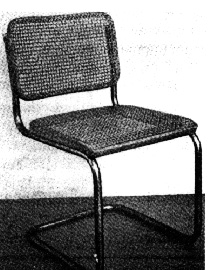
Figure 28. Breuer Elastic Cantilever chair of 1929.
From the tubular steel designs emerged the 'moulded ply-wood' form, offering a myriad of choices to the designer as the ply-wood could be pressed into complex curves and shapes, allowing almost complete freedom in the final shape. The work of Charles and Ray Eames, famous American designers, perfected a plywood moulding technique which they used to develop their popular designs. These designs are representative of the type of chairs that sold well and were widely copied from the 1940's to present (see Figure 29).
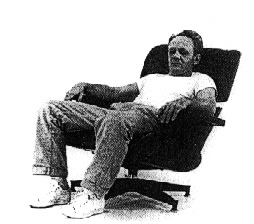
Figure 29. Eames plywood chair.
Chair design and manufacture by this time had become big business, resulting in the further specialization of its designers. The architects were left to design buildings, with a new profession; the 'Industrial Designer', assuming the chair as part of their portfolio of concerns. New philosophies of design emerged from this group. Styles become formalized with perhaps the most prominent of this time being 'streamlining', as seen in the cars, appliances and furniture; with curves and flowing lines used to accentuate the 'modern'. Furniture was freely available to the masses and the new consumer tastes that were developing. Chairs had become a common part of each persons working and home life, providing a place from which to work, eat a meal, or just a place to relax. Manufacturers were competing to have their styles accepted and adopted by the public and the institutions that housed them during their work or leisure time.
The industrial designer does more than trace curves. The studios of the leading design firms, where often over 100 draftsmen are employed, also undertake market research, re-organizing of stores or factories, as well as design of building. Thus they must be decorative artists, architects and organizers in one. For them only one consideration counts: the merchandiser, dictator of taste in the United States...Now in the time of full mechanization, reform takes place under the dictatorship of the market. All other considerations are secondary. (Geidion, 1948 15) p. 610
3.6 The Post Modernist EraChair design and the marketing of chairs divided into basically three distinct types to meet the demands of the consumer. Chairs designed for institutional purpose, chairs for the home and general consumer use, and chairs as a form of artistic expression. new materials were continually deployed and with the development of plastics, blown foam and urethanes, along with synthetic coverings the designer had almost unrestricted options with which to create. Figure 30 shows an example of artistic expression in a chair design.
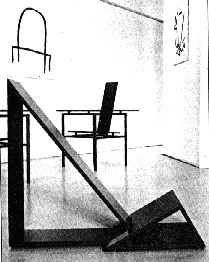
Figure 30. De Graaf chair of 1985.
Nearly all designers, it seems are attracted to designing a piece of furniture. Architects are convinced the chair is architecture writ small; industrial designers are intrigued by the problem of combing mass-manufacture, modern materials, new technology and good looks in a field which, unlike that of other consumer durables, has in the past resisted change; and men and women who would previously become fine artists have adopted furniture as a medium for self expression and comment. (Dormer, 1987 22) p. 8.
The chair is designed to communicate with its audience, to expound the wealth and style of the owner, and determine the sitting arrangements expected of the users. Designers play with these variables in order to develop an aesthetically pleasing design that was also commercially viable.
The mass market demanded a stratification or segmenting of the chair manufacturers products. Low cost, mass produced chairs were targeted to the middle classes. International trade between the developed countries ensure the chairs dispersion. The style was most notably of simple geometry, with the chair having thin legs, a thin seat usually contoured, and a curved backrest to support the body, Perhaps the epitome of this style is the kitchen chair. The lounge chair, emerging during the reign of the upholsterer as chair designer, is further developed to blend into room spaces in a harmonious way. Their luxuriance, the carefully selected fabrics and large expanse of soft padding invite the sitter to collapse into their forms. Support is provided for the body with little thought given to the ultimate posture the seat demands.
The office chair attempts to balance a number of variables to provide an aesthetic technological and architectural design to attract buyers. It is also recognised as a tool of 'social engineering'. The chair will determine how people are arranged in social space, the importance of the persons position or status, and the nature of their work. Chairs for working purposes are clearly distinguished from chairs in which the sitter is invited to relax, such as the reception chair.
Some of the work chairs within institutions are designed to be stackable for easy storage and rearrangement of seating configurations, as well as durable and moderately priced; such as those used in schools, lecture theatres and conference rooms. They are often moulded in one piece, from polypropylene or plywood supported by a thin metal frame. These chairs are uniform in size without any consideration for anthropometric differences amongst people, rather they seem to represent an egalitarian notion of sitting.
The office or work chair has become a challenge for industrial designers and most recently in the scientific community in the guise of the "Ergonomist". Earlier designs of the 'contemporary chair' are reminiscent of the Patent era, with movable backrests, adjustable seat heights and pivoting seat pans. In an ad hoc evaluation of office chairs (1985), a design journalist Helen Buttery, asked various professionals to assess a number of office chairs.
...there are several chairs which are good and which...seem comfortable, but no one can agree which is the best since sitting remains a personal activity...Buttery learned the current ergonomic tenet: that there is no correct sitting posture and that it is good for the spine to be in constant movement. So the orthodoxy in office chairs now is a backrest that moves with the sitter. One of the testers concluded that you really needed to learn to sit properly and then you would not need the gimmicks. But because many people do not learn to sit properly, the designer's task is to accept this as one of the 'givens' and design in those very features which are too easily dismissed as gimmicks. (Dormer, 1987 22) p. 92.
This rather contentious notion has become the hallmark of ergonomics research in the area of sitting. The Norwegian furniture manufacturer, Westnofa, adapting the designs of Peter Opsvik and Svein Gusrud, have approached sitting and chair design from a different perspective. The 'Balans' range of chairs, now sold worldwide, suggest that by changing the angulation of the thigh, pelvis and spine, a balanced self supporting sitting posture is possible without the need for back support. This notion is new to the history of chair design, and as yet the market and the general ergonomic community seems undecided.
In Western society, the chair has become integral to the notion of posture. The new chair designers assuming responsibility in the current era are the ergonomists. This group, emerging from the science and engineering fields are attempting to apply their tools to understand the physiological, anatomical and psychosocial factors that may lead to better chair design. To suggest, after the long evolution of the chair and supported sitting in Western culture, that we are still not quite sure how to best sit people, is an interesting question, about which a great deal of ergonomic research has concerned itself.
ReferencesBaker HS (1966): Furniture in the Ancient World. London: The Connoisseur.
Dormer P (1987): The New Furniture: Trends and Traditions. London: Thames and Hudson Ltd.
Geidion S (1948): Mechanization Takes Command: A Contribution to an Anonymous History. New York: W.W. Norton and Company.
Hayward H (Eds) (1975): World furniture. London: Hamlyn.
|
|
39 High Street, Dulverton, Somerset, TA22 9DW. tel. 01398 323286 e-mail peter@exmoorantiques.co.uk
Date of Origination: Saturday, 4-Mar-2017... 10:15 AM
Date of initial posting: Wednesday, 08-March-2017... 10:45 AM
Updated posting: Saturday, 31-March-2018... 12:24 PM